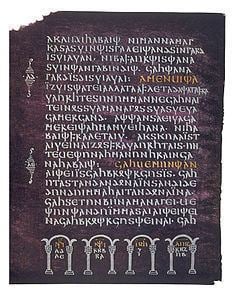 | ||
Similar Codex Argenteus, Encyclopedia of Indo‑Euro, The Horse - the Wheel and Lang, Indogermanisches etymologisches Wörterbuch, Samaritan Pentateuch | ||
Gothic bible armour armor of god ephesians 6 10 18 wulfila gothic language 4th century
The Gothic Bible or Wulfila Bible is the Christian Bible as translated by Wulfila in the fourth century into the Gothic language spoken by the Eastern Germanic (Gothic) tribes.
Contents
- Gothic bible armour armor of god ephesians 6 10 18 wulfila gothic language 4th century
- Codices
- Historic context
- Modern importance
- References
Codices
Surviving fragments of the Wulfila Bible consist of codices from the 6th to 8th century containing a large part of the New Testament and some parts of the Old Testament, largely written in Italy. These are the Codex Argenteus, which is kept in Uppsala, the Codex Ambrosianus A through Codex Ambrosianus E, containing the epistles, Skeireins, and Nehemiah 5–7, the Codex Carolinus (Romans 11–14), the Codex Vaticanus Latinus 5750 (Skeireins), the Codex Gissensis (fragments of the Gospel of Luke) and the Fragmenta Pannonica, and fragments of a 1 mm thick metal plate with verses of the Gospel of John.
Historic context
During the third century, the Goths lived on the northeast border of the Roman Empire, in what is now Ukraine, Bulgaria and Romania. During the fourth century, the Goths were converted to Christianity, largely through the efforts of Bishop Wulfila, who invented the Gothic alphabet and translated the Bible into the Gothic language in Nicopolis ad Istrum in today's northern Bulgaria. Portions of this translation survive, affording the main surviving text written in the Gothic language.
Gothic Christianity differed from Catholic and Orthodox doctrine as to the divinity of Jesus, with the Gothic Christians maintaining that Jesus was a creation of God, rather than being God himself. The Goths rejected the Holy Trinity (see Arianism).
During the fifth century, the Goths overran parts of the Western Roman Empire, including Italy, southern France, and Spain. Gothic Christianity reigned in these areas for two centuries, before the re-establishment of the Catholic Church, and, in Spain, till the mass Gothic conversion to Catholicism in 589 AD, during the Third Consilium of Toledo.
Modern importance
The Wulfila Bible, although fragmentary, is the only extensive document in an ancient East Germanic language and one of the earliest documents in any Germanic language. Since the other East Germanic texts are of very limited extent, except maybe Skeireins, it is of great significance for the study of these languages.
